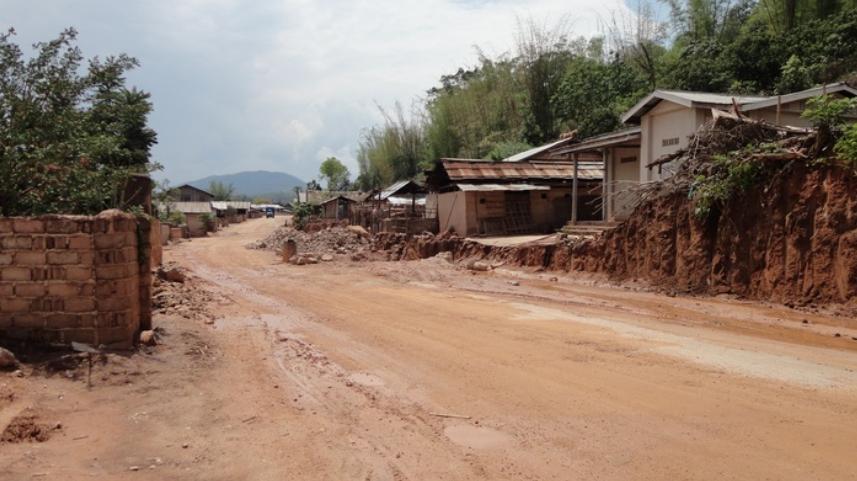Farmers from more than 60 villages in Kunlong township, northern Shan State, didn’t know what to expect when Asia World Group began bringing “big trucks” into the area in 2012. They soon deduced that one of six mega-dams slated for Burma’s Salween river was being built to usher 1,200 megawatts of energy to neighbouring China.
The Shan Human Rights Foundation (SHRF), an advocacy group representing the ethnic minority, has called for the immediate suspension of the project, which they say has led to massive uncompensated land seizures, human rights abuse and military occupation.
“We would like the government to immediately stop this kind of big project and listen to the local people’s voices,” said Sai Hor Hseng, spokesperson for SHRF, speaking to DVB by phone.
Last week SHRF published the findings of field research conducted between April and December 2013 in a report documenting the effects of the Kunlong hydropower project in dozens of villages, some located downstream from the dam site, and some in the way of a 100 km highway connecting northern Shan State to China via the border town of Chin Shwe Haw.
Villagers told SHRF that a 50-ft wide stretch of land was confiscated reaching from Hsenwi to Chin Shwe Haw; farms, shops and homes, they say, are being indiscriminately removed.
[related]
“Since they built the road, our house shakes when the big trucks pass by,” said one villager cited in the publication, who went on to explain that during construction, dirt was dumped en masse by the roadside. When it rains, the villager said, the dirt gets swept into farmlands and waterways, leaving them “destroyed”.
SHRF observed some of the damages along the highway route, but could not swing a visit to the dam site just upstream from Kunlong town. Sai Hor Hseng explained that, “We tried to go to the dams, but, unfortunately, the fighting occurred and we could not enter.”
Kunlong, near the northern edge of Burma’s eastern Shan State, sits at the convergence of Shan, Kokang and Wa administrative boundaries, and is home to a variety of ethnic militias that — despite the nation’s progress towards signing a nationwide ceasefire — are still engaged in combat with the Burmese armed forces, according to local reporters and aid workers.
In December 2013, local police verified that a bomb blew up a bulldozer and killed three people in Kunlong along the Hsenwi-Chin Shwe Haw highway, though the act has not yet been attributed to any individual or army.
SHRF contends that conflicts are made worse by the erection of new military structures and the installation of additional troops in the area for project security, a familiar accusation by locals near several of Burma’s biggest development projects. In this particular region, the SHRF report said, not only does the presence of Burma Army soldiers cause extreme anxiety among ethnic villagers, but soldiers are still “seizing lands” to build new bases.
“They hold guns,” one villager told SHRF. “They can do anything they like.”
Upon contacting Burma’s Ministry of Defence on Monday, DVB was informed that the ministry’s Principal Officer was unauthorised to comment on whether more troops had been deployed to the area over the past two years, nor did he have the authority to respond to claims that lands had been seized or destroyed.
[pullquote]“They hold guns,” one villager told SHRF. “They can do anything they like.”[/pullquote]
The Salween River is one of the longest free-flowing rivers in the world — stretching about 2,800 km from Tibet to the Andaman Sea — and is thought to support the livelihoods of nearly ten million people. The Kunlong dam is among the largest of six hydro projects planned for the Salween within Burma alone. Further upstream, an additional 13 dams are set to be built in China.
In 2010 the Burmese government and China’s Hanergy Holdings Group, a private corporation based in Beijing, signed a Memorandum of Understanding for the development of the Kunlong dam. A public partnership announcement, found on the company’s website, said that it was “the largest project to date for the Myanmar [Burma] government with a Chinese private company.” Hanergy’s spokesperson, currently out of office, has yet to respond to SHRF’s allegations or media inquiries.
SHRF reported that Hanergy contracted Burmese firm Asia World Group to construct the 100 km highway and other related infrastructure. The group expects that the project will be complete and operational by 2018, though neither firm has responded to DVB‘s requests for confirmation.
According to environmental group Salween Watch, an Environmental and Social Impact Assessment (ESIA) has been conducted but was never made public, adding that “Construction has started in secrecy”. Little information about the Salween dams exists in the public realm, and Asia World representatives have thus far been unresponsive to press inquiries and allegations made by rights groups.
This dearth of information, said Sai Hor Hseng, is really at the heart of the matter. “The project lacks transparency. We don’t have any contact with them,” he said. DVB asked him whether either Asia World or Hanergy have responded to SHRF’s claims that locals are being abused and displaced, which the group has been saying for years.
“No, not yet. We haven’t heard anything yet,” he said.



